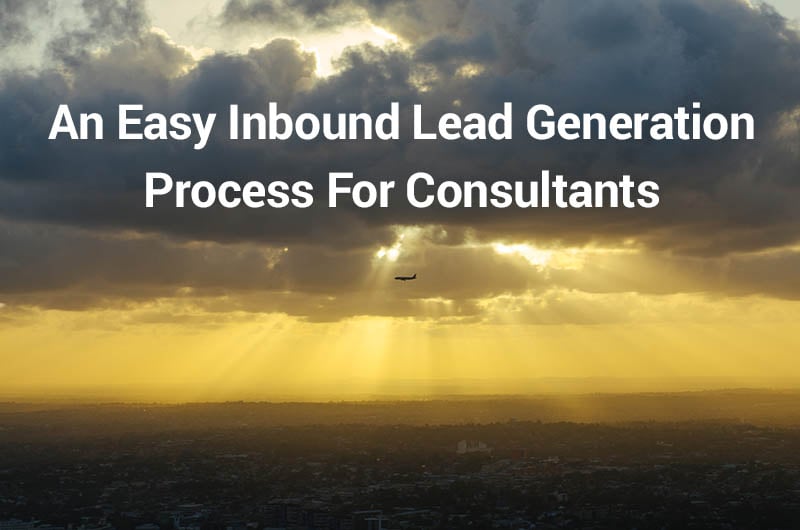
Inbound marketing depends on expertise. Your prospect has a problem or concern, and they look online for an expert opinion on how to solve it.
Inbound marketing positions you to share your expertise with prospects, and gain the business generated as a result. As a consultant, solving problems is part of your job description, so inbound is a perfect fit. If you're a consultant and you're not using inbound marketing, you've put yourself at a competitive disadvantage.
Follow the five steps ahead to build an easy, reliable inbound lead generation process that delivers real results.
1. Build a user-friendly website
Your website should be the central hub of your inbound lead generation process. It's the home of your content, the digital face of your business, and the place prospects come to learn about what you have to offer. If you want your website to make the right impression, it needs to be designed with the user in mind.
Simple navigation is a great place to start. Too many otherwise solid websites are doomed to obscurity by poor navigation choices. Make sure your navigation links contrast well with the rest of the page, and use drop-down menus to keep your navigation bar from getting too crowded. It's also important to provide easy options for engagement, and tailor your marketing materials to your target audience. Create a persona for your ideal customer, and build your website with that person in mind.
2. Put your inbound marketing software to work
Manage your inbound lead generation efforts efficiently by choosing the right software for the job. Your inbound software should offer value at each step of the marketing process. It's a place to keep track of your customers, and their position in the purchasing cycle. Inbound software helps you manage relationships more effectively, and allows you to track your marketing efforts through analytics.
That last part is key. Analytics allow you to understand what you're doing, how it's working, and what you can improve upon in the future. The feedback you get from analytics should guide your inbound marketing, allowing you to continually trim the fat and keep your marketing running at maximum efficiency.
I'm a little bit biased, but I recommend HubSpot as the software of choice for consultants. It provides a complete sales and marketing solution including a CRM and the various components of the software integrate seamlessly.
3. Create compelling content and promote it effectively
As a consultant, you're especially well-equipped to create valuable content for your target audience. Your title and skills give you built-in authority, and your experience gives you the knowledge to comment thoughtfully on topics of influence as a trusted adviser. When you create content, you're essentially giving readers a “free sample” of your knowledge.
Solving a problem is the simplest, most effective way to create compelling content. Answer questions that you frequently receive from clients, and engage on social media to get suggestions from your audience directly. Don't be afraid to take a position, and show off a little personality. Once you've got great content, promote it! Share it through your social feeds, and ask readers to pass your content on if they found it helpful.
4. Use email marketing to keep the conversation rolling
What makes you open one marketing email, while ignoring another? Better yet, what keeps you from clicking the spam button once you open it? If you want your email marketing to make an impact, it needs to be crafted with your customers in mind. That means offering real value – special tips, exclusive content, the latest inside news – and avoiding the temptation to send too many messages.
Your email marketing is a way to continue the conversation with your prospects, and stay at the forefront of their minds. Flood their inbox every other day with marketing fluff, and you punch a one-way ticket to the spam folder. Send carefully crafted content at reasonable intervals, and your email list members will look forward to receiving your next message.
5. Remember that Engagement is a Two-Way Street
At its core, inbound is about building relationships with prospects. If you've followed our inbound lead generation process so far, then your content, website, and email marketing are already laying the foundation for those relationships. Now it's time to engage directly.
The insights gained from your inbound marketing software will allow you to reach out to the right people, at the right time. Look for opportunities to engage your prospects, online and in person. Your inbound marketing teaches the prospect about your business, but it also teaches you a lot about the prospect. Use that data to steer the conversation in a mutually beneficial direction.
With inbound marketing, you get out what you put in. Build a user-friendly website, and prospects are more likely to visit it. Create valuable content, and they're more likely to read and share it. Participate in the conversation you generate, and you're more likely to keep the prospect engaged until it's time to convert. Pay attention to the key details as you build your inbound lead generation process and selling your consulting services will be easy.







